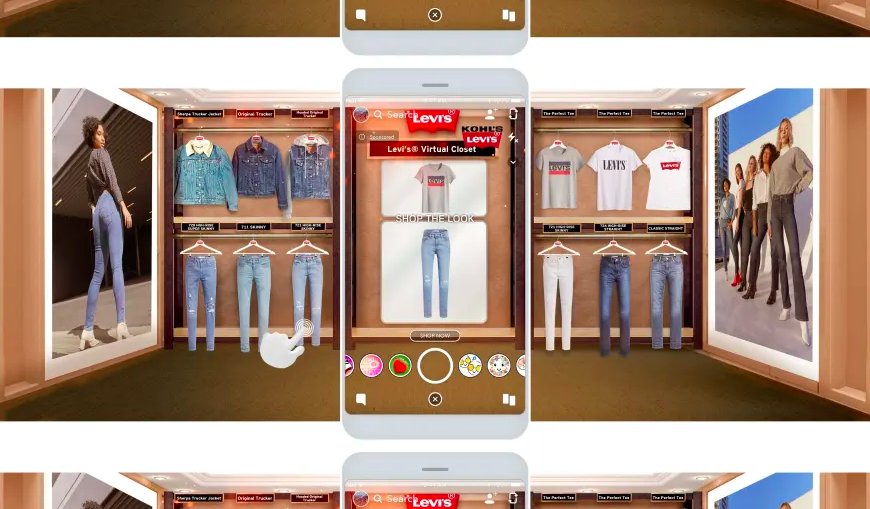Table of Contents:
- Introduction
- Expansion Plans
- Direct to Consumer Strategies
- Consumer Behavior Data
- Personalization
- Product Customization
- Artificial Intelligence
- Levi’s Mobile App
- Conclusion
Introduction
An exceptional pair of jeans never goes out of style, and while apparel has evolved over the years, denim as a wardrobe staple remains timeless. Founded in 1853, by Levi Strauss himself, Levi Strauss & Co. has dominated the retail industry for over a century. Levi Strauss’ net sales reached approximately 5.76 billion U.S. dollars in 2021.
Levi’s focused on selling directly through its own channels, both online and in stores since the closures of wholesalers like Kohls and Nordstrom during the pandemic. As Levi’s set up its direct-to-consumer business for retail and ecommerce stores, the company is harnessing the power of consumer behavior data, personalization, product customization, and artificial intelligence to drive sales.
Not only the latest technology but it is also important to deliver an experience that shoppers can resonate with. With their best-in-class, brand immersive, digital ecommerce, the brand is looking to take the sustainable shopper experience to a whole new level, winning over the Gen-Z.
With the goal to become the world’s best digital apparel company, Marc Rosen, president of Direct-to-Consumer previously is now the president of Levi Strauss Americas. Rosen is building a digital, ecommerce, and direct-to-consumer (B2C) model using the nostalgic power of Levi’s brand and its innate ability to connect with people.
Expansion Plans
Levi Strauss & Co. is taking bold steps to achieve global growth and diversification, with a focus on direct-to-consumer (DTC) channels and broader product offerings. They aim to add 400 new stores and triple their online sales by 2027 while upgrading existing stores to offer an elevated shopping experience with digital integrations.
Levi’s is also expanding beyond denim jeans to offer a wider range of apparel, including tops, dresses, and accessories, with a particular focus on nascent markets in Asia. Collaborating with influencers and designers to attract new customers, integrating sustainable practices throughout their supply chain and product development, and investing in technology are other key strategies.
These expansion plans aim to achieve a net revenue of $9 billion to $10 billion by 2027, reflecting an annual growth rate of 6-8%. While it presents opportunities and challenges, Levi’s is poised to adapt to changing consumer preferences and maintain market relevance.

Direct to Consumer Strategies
The denim giant’s new fleet of ‘NextGen’ retail and ecommerce stores offers an inventory assortment using customer data and AI, a tailoring service, larger fitting rooms, incorporation of Levi’s mobile app, and much more.
1. Consumer Behavior Data
Levi’s started building data science capabilities to utilize consumer behavior data to drive decisions. The data shows how people shop, the trends they follow and what merchandise they are buying. Also, providing in-depth insights to designers at the beginning of the creative process. Additionally, Levi’s is boosting sales from associate ordering, a capability that helps ensure they don’t miss a sale and caters to how younger consumers are shopping.
2. Personalization
The brand created a Digital Enterprise Office to use the consumer behavior data to drive personalization and stand out in the digital space. In addition, for ecommerce stores, Levi.com launched a new product recommendation engine that tailors the online experience for each customer based on their profiles, browsing, and purchasing habits to increase revenue.
3. Product Customization
Levi’s launched its additional customizing service – Levi’s Tailor Shop. Customers can personalize their Levi’s apparel with a variety of studs, embroidered patches with initials, or logos from their favorite music bands with this customization service. Additionally, direct to consumer retailers like Levi’s offers a range of tailoring services that include hem shortening, leg width adjustment, ripping, mending, aging, abrasion, and decoloring, which are already available in stores.
4. Artificial Intelligence
Katia Walsh, the chief AI and strategy officer of this established legacy brand launched the company’s eight-week machine learning boot camp for employees. This AI program unlocked growth, automated tasks for employees, and also helped in predicting what style and price will sell best in each location. For example, AI helps to automate their color-matching process to free up time, so designers can be more creative.
5. Levi’s Mobile App
According to Forbes, Chip Bergh, CEO of Levi Strauss & Co said that revenues coming from Levi’s mobile app have exceeded internal expectations and shown month-over-month growth. All Levi’s mobile app features below are aimed at fostering and growing the brand’s connection with its target audience:
- It features direct to consumer branding with curated editorial and brand content that tells the backstory of your favorite products
- Users can purchase premium items only available through the app, such as Levi’s® Authorized Vintage Truckers and Levi’s® x Star WarsTM collaborations
- It also showcases collaborations with high-end fashion brands, providing digital access to products that were previously only available at NextGen stores and brick-and-mortar boutiques
In addition to the mobile app, Levi’s loyalty program membership grew 35% during the first quarter to more than 5 million members.
6.Brick-and-Mortar Retail Stores:
In addition to its online presence, Levi’s operates brick-and-mortar retail stores worldwide. These flagship stores and outlets serve as key touchpoints for customers to experience the brand firsthand, receive personalized styling advice, and participate in in-store events.
7. Pop-Up Shops and Experiential Retail
Levi’s frequently hosts pop-up shops and experiential retail events in high-traffic locations, offering immersive brand experiences and engaging with customers in innovative ways. These temporary installations allow Levi’s to connect with consumers on a deeper level and generate excitement around its products.
Conclusion
Whether buying across retail or ecommerce stores, Levi’s delivers a seamless consumer experience. The company connects the online to offline experience and is piloting new convenience-oriented in-store features like store and curbside pick-ups, line-queuing tools, in-store personal shopping appointments, and contactless returns.
Levi’s is a brand that has been renowned for its one-of-a-kind innovation, especially around its digital efforts. Also, Levi’s is leveraging the latest technologies, AI capabilities, personalization, customization, and much more to accelerate digital transformation and increase revenue and conversions. With younger consumers engaging with them more times per month and longer per visit, Levi’s is poised to become a consumer-direct digital powerhouse.
Jeans being Levi’s prime product, you can browse their website for Levi’s jeans size chart, where Levi’s jeans are made, Levi jeans fit guide, Levi jeans guide, Levi jeans size guide, Levi jeans founder, Levi jeans customer service, Levis jeans return policy, Levi jeans in store, etc. Also, for Levis store NYC, Levis store San Diego, Levis store Chicago, Levis store Boston and Levis store hours, check out their official website here.
Deepak Wadhwani has over 20 years experience in software/wireless technologies. He has worked with Fortune 500 companies including Intuit, ESRI, Qualcomm, Sprint, Verizon, Vodafone, Nortel, Microsoft and Oracle in over 60 countries. Deepak has worked on Internet marketing projects in San Diego, Los Angeles, Orange Country, Denver, Nashville, Kansas City, New York, San Francisco and Huntsville. Deepak has been a founder of technology Startups for one of the first Cityguides, yellow pages online and web based enterprise solutions. He is an internet marketing and technology expert & co-founder for a San Diego Internet marketing company.








